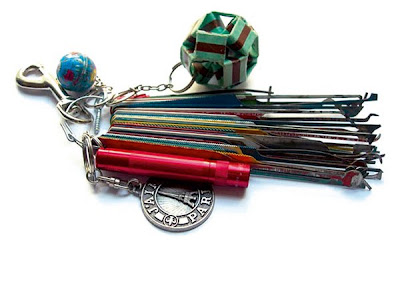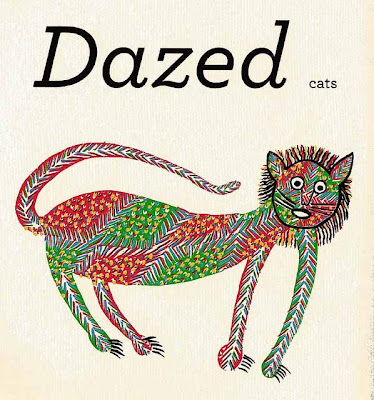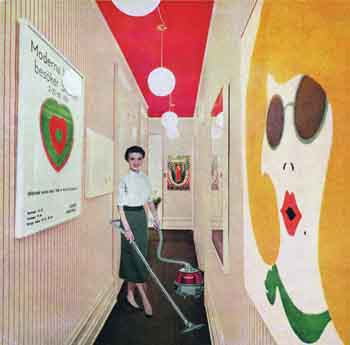
Bojan Šarčević, World Corner, 1999, bricks, plaster, wallpaper, wood. Installation view, Carlier/Gebauer, Berlin.
“TO WHAT EXTENT SHOULD AN ARTIST understand the implications of his or her findings?” This is the cryptic question that Bojan Šarčević posed to a panel of artists, critics, and curators he’d convened on the occasion of his 2006 two-venue exhibition in Ireland, at the Project Arts Centre, Dublin, and the Model Arts and Niland Gallery, Sligo. The show debuted a group of works—miniature geometries of brass threads dangling almost imperceptibly against an expanse of elegantly distressed wallpaper—that appeared far from the kind of research-based production his query would seem to address. Yet the seminar, held at the Dublin venue, was no mere discursive supplement. If Šarčević broached the broader topic of meaning in art—as was borne out by the ensuing expansive and open-ended discussion, which took the outcome out of the artist’s hands and offered no easily summarized “findings”—he also answered its own question. And this response was articulated via the creation of a defined structure (in this case, the colloquium form) that serves as an engine of relatively unbounded knowledge production. It’s precisely this kind of generative and multiplicitous rubric that has unified Šarčević’s stylistic shape-shifts, over the past decade or so, through roughhousing architectural interventions, films and videos, delicately filigreed sculptures, and a diversity of photo-based work.
The problem was that, thanks to the presiding doxa of reception, readings of Šarčević’s work had tended to overlook this central strategy. There are understandable reasons for this. Consider, for example, one of Šarčević’s earliest pieces, World Corner, 1999, for which he physically extracted the corner of a room in a condemned apartment building in Amsterdam, cut an equivalent-size corner from a room in Berlin’s Carlier|Gebauer gallery, and fitted the Dutch corner into the German gap. While the new addition sat more or less flush with the venue’s walls and floor, a suture of splattered plasterwork around it made plain that a transplanting process had occurred. And in this sense, World Corner would seem to map onto Šarčević’s peripatetic background: Born in Belgrade, he lived with his family in North Africa for some years, then moved to Sarajevo as a teenager. At the age of seventeen, at the outset of the Bosnian war, he left that city and has since sojourned in Montreal, Paris, Amsterdam, and Berlin (where he now lives). So far, so tidy: World Corner’s suggestions of migration and adaptation chime with Šarčević’s Eastern European name and far-flung, war-torn background, offering, in a highly respectable post-Minimal idiom, an allegory of geopolitical instability, nomadic drift, and contingent identity. But while Šarčević is not unconcerned with these issues, this isn’t how his art communicates, where it originates, or how it is internally organized.
Šarčević’s interest, in the case of World Corner (which was shown on two further occasions, in Watou, Belgium and Paris), lay in upending and refocusing the experience of a given space, in creating something at once incongruous and assimilated, in making a collage in three dimensions. He was, he says, inspired by a memory of Jean Eustache’s film Une Sale Histoire (A Dirty Story, 1977), in which a man describes discovering a peephole in a Paris café’s bathroom and fantasizing that this aperture predates the whole city, which grew up around it. When World Corner was plugged into a gallery space, it too seemed paradoxically both a foundation and an empty center. It was evidently older than what surrounded it; figuratively speaking, it might have been the cornerstone on which each structure was built.
Glimmering here is the idea that the conceptual ambit of Šarčević’s art might be disproportionate to its apparent physical restraint. Though his work always seems to be shifting gears in terms of medium and appearance, it consistently demonstrates what multitudes a particle of reality can contain when it is unmoored from its context, and how that untethering might modulate experience on the visual—as opposed to critical or conceptual—plane. We can see this dynamic in other early works—for example, Favorite Clothes Worn While S/He Worked, 2000, for which Šarčević persuaded members of various uniformed professions (including maids and car mechanics) to spend two weeks working in their “best” clothes and then exhibited the stained results in a pseudo-museological display. Here, carried over from World Corner, is an impulse to simultaneously emphasize and normalize incongruities. Favorite Clothes . . . engages other issues as well, e.g., labor’s indignities and its insidious colonizing of the self. But at the same time, these works are rooted in a notion of the material trace as suggestive origin; both prompt viewers to build outward—into a hemisphere of delimited signification—from what is effectively abstract mark-making, as invested in texture and facture as Dieter Roth’s grease stains or Lee Bontecou’s soiled, cut-up conveyor belts.

Bojan Šarčević, Favorite Clothes Worn While S/He Worked, 2000, twenty-seven wardrobe items, MDF tables. Installation view, Gesellschaft für Aktuelle Kunst Bremen, Germany, 2000
Rather than viewing them as determinative, a stable platform on which interpretation can be built, one might see the external references that Šarčević offers in such works as something like the fragments of an old, decaying scroll: They at once serve as points of orientation and imply, materially, the vast expanse of everything that isn’t there to be read. They thus take an audience accustomed to reading works of art, unlocking predetermined content, and treating reception as a form of mastery and set them afloat in endlessly bifurcating realms of signification, inviting them to fill in the blanks themselves. This is especially clear in two works whose references are loaded indeed: Spirit of Versatility and Spirit of Inclusiveness, both 2002, are corner-hugging mimicries of decorative detailing from holy places. The former is a painted-wood, silvery-gray, sci-fi-looking spread of interlocking geometric forms based on muqarnas, the richly niched corbels found in mosques; the latter is a life-size replica, in glowing plates of steel, zinc, brass, and copper, of one of the curved, vaulted corners of Cologne Cathedral. Particularly in the wake of 9/11, this overt counterposing of Christianity and Islam might conjure a nimbus of sociopolitical import and rhetorical intent. But in fact, via its mismatching of aesthetic regimes, the work undoes the kind of neat conceptual symmetry (e.g., Samuel P. Huntington’s Clash of Civilizations and the Remaking of World Order [1996]) that would enable such a reading. What both works offer is undeniable and estranged material presence: Here, Šarčević makes Islamic architecture feel startlingly futuristic and allies Christianity with the textures of Minimalism. To the extent that Spirit of Versatility and Spirit of Inclusiveness do contain a political or topical argument, it may consist in the notion that failure of imagination—the kind that posits two religions as a simple binary—is itself an ethical transgression.
In later works, the referential quality becomes ever more oblique, while the work itself seems to move toward formal transparency—as if to delineate a kind of ether in which viewers’ projections of meaning could remain suspended. Keep Illusion for the End, 2005, for instance, is a large, freestanding geometric framework of overlapping and crisscrossing three-dimensional outlines—zigzagging lengths of brass, copper, wood, and concrete recede like afterimages behind an irregular polygon made of slender wooden strips—which, seen from one angle, snap into focus to suggest the flattened silhouette of a house. The airy, diagrammatic whole, an elegant study in form and line and (absence of) volume, has a refined neomodernist feel. But the overly elaborated zigzags, reminiscent of Art Moderne moldings, also suggest decor details such as coving. Like the Spirit of . . . sculptures, this work puts ornament center stage. In a doubly wry inversion, modernism is remade out of what it repressed, and abstraction is made to do the bidding of its former nemesis, figuration.
Yet while all of this usefully lends itself to talking about the work, these projects could perhaps also be recouped as simply the sediment of the artist’s daily life, rather than as Šarčević’s attempt to insert his art into a history of ideas. His creative method, he says, frequently finds him trying to reconstruct and amplify some splinter of the real. While World Corner sprang from his walking the streets of Amsterdam, Šarčević was living in Berlin, surrounded and fascinated by early-modern architecture, when he made Keep Illusion for the End and related pieces, such as the sleek copper stack of inwardly curving, loosely enclosing banister-like forms Wanting Without Needing, Loving Without Leaning, 2005, or “1954,” his 2004 series of black-and-white collages that upend the regimented spatial logic of modernist interiors. And describing these latter works’ ostensible thematics doesn’t, in any case, fully account for their physical or material fundamentality, which is elegant and anorexic, old and new, and suggests that the work doesn’t primarily require interpretation (although it can take it). If we tend to apprehend and remember the world in glancing, indelible details, Šarčević’s approach suggests, then an art that harvests and compounds such fragments ought to be a model of, and a cue for, an upgraded state of awareness, of being in the world—a model that invites surrender to the comparative aphasia of an underinscribed encounter, one that doesn’t come with a predetermined meaning.
An untitled 2006 series—of which Šarčević’s inconspicuous sculptures for Dublin were an outrider—found him bending and welding slender lengths of brass and stringing them with threads, like alien harps or sextants, before fixing them to walls that had been partly painted or wallpapered and partly stripped. The linear elements form a set of emphatic, specific, yet opaque formal decisions for the viewer to navigate, mitigated by what has increasingly become a hallmark of Šarčević’s art: a rare, abstract beauty. Once again implying a kind of three-dimensional collage, this procedure morphed across parallel groups of works created the same year. The brass geometries were strung with patterned silk scarves from a Berlin market, in a sensuous conversation between textures. They then found themselves standing like forlorn miniature pylons on complexly planed white cardboard plinths. And this tableau form was adapted (with the brass threads going with it) for Šarčević’s 16-mm film series “Only After Dark,” 2007, and “The Breath Taker Is the Breath Giver,” 2009.

View of Bojan Šarčević, “Only After Dark,” 2007, Centre d’Art Contemporain d'Ivry—le Crédac, Ivry-sur-Seine, France. Photo: André Morin.
The five films that compose the former series are all less than three minutes long, screened within specially made chambers that underline their quality of rapt hermeticism, and accompanied by downbeat and dilatory improvisations for piano, percussion, guitar, and kora. In each, the camera racks up static views of precise arrangements of shardlike Perspex uprights (L-shaped, like corners); groupings of ragged wood, brass, and curved paper; and origami-like card constructions, miniature stone obelisks, and a hunk of red meat that, at the end of the final film, appears to pulse like a beating heart. The accumulation of different angles on coordinate-free scenarios—expanded, in the four-part “The Breath Taker Is the Breath Giver,” to include miniature wooden architectures festooned with strings and nestling in sand; alien-looking, hair-covered objects resembling Chinese scholars’ rocks; and ravishingly lit alignments of crumpled colored tissue, cardboard, and a hank of blond hair—turns Šarčević’s camera into a proxy for the perplexed but entranced viewer, able neither to fully understand nor to look away.
The editing style, which involves restless cutting among the tableaux, meanwhile imparts to Šarčević’s subjects a quality bordering on animism. (The artist has said that he wanted the sculptural elements to be almost like protagonists, desiring to communicate with one another.) They hover, poised between sentience and dumb objecthood. The film’s liminal objects are echoed in a series of sculptures of surpassing delicacy (“Involuntary Twitch,” 2010), in which horizontal brass plates are held precariously within a system of notched, willowy steel poles. Though they’re composed of hard metals, these assemblies are inestimably fragile—a paradox that conveys itself unnervingly as viewers realize that these scaffolds are literally quivering in the gallery’s air currents. And though they resemble modular shelving systems, they’re resolutely nonfunctional (unless one has, say, a selection of feathers to display). These are near-abstract works haloed by panoplies of cloudy reference—their modernist aspect, for example, is at once present and hard to pin down.
This isn’t mystification for its own sake. For an artist to assign specific meaning to his or her own work—to seek to control “the implications of his or her findings”—is, by Šarčević’s lights, a kind of legislation or moralizing. It’s also deeply limiting, foreclosing the possibility of art’s accessing its profounder registers: where the viewer, rather than decrypting a piety, has a journeying encounter. On that voyage, Šarčević is still a guide but not an autocrat. It is here, one would say, that the tactical élan of Šarčević’s programmatic use of fragments and details might be seen. A sliver of the real, particularly when coaxed into the kind of exquisite obliqueness that he specializes in, is a starting point, asking to be followed through—refusing openness but allowing the viewer to do the completing. The rich specificity of Šarčević’s fragments, their near-Romantic keying to particular places and historical moments, creates spheres of interpretative potentialities, from the aesthetic to the sociopolitical. The artist refutes “meaninglessness,” the perilous obverse of opening up signification—but doesn’t turn the artwork into a cipher.
In 2007, Šarčević produced an artist’s book that juxtaposed images from the whole of his career with texts extracted from a 2004 paper on the transitioning Western Balkans, commissioned by the European Union Institute for Security Studies; he titled the volume Kissing the Back of Your Hand Makes a Sound like a Wounded Bird, densely alloying specific political realities and expansive poetic polysemy. One might consider this a distillation of what Šarčević is asking for: not an outright rejection of the content-driven approach that has dominated the art of recent decades or a wholehearted return to the modernist formalism that preceded it, but a realization that the two models were artificially cleaved all along. Vouchsafed here is a synthetic practice that does not displace experience—looking, feeling—in favor of decoding and that still acknowledges the existence of the outside world. This is an old modernist problem, but one that stalks us still. What we need is neither an erotics nor a hermeneutics of art, Šarčević wordlessly affirms. We need an art that calls for both at once.
Text by Martin Herbert
Source:Artforum , Nov.2010













